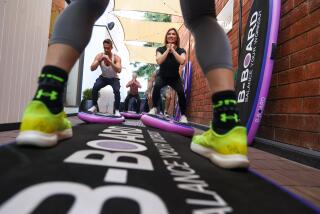This choreographer is all wet
SPREADING across the Southland in an intricate web of highways and byways, Los Angeles is not an easy place to get to know, let alone love. Compared with other urban regions, its size and sprawl can frustrate a newcomer’s efforts to grasp the totality of the city.
Yet for choreographer Stephan Koplowitz, who relocated here two years ago after living in Brooklyn, N.Y., for 24 years, becoming acquainted with L.A. has been a welcome surprise.
FOR THE RECORD:
Choreographer’s collaborator: An article about site-specific dance in Sunday’s Calendar section said choreographer Hana van der Kolk had collaborated on a stop-motion film with Adam Overton. Her collaborator was Michael Parker. —
“I used to say that if New York City was an egg, Los Angeles was that egg dropped and splattered on pavement,” says the new dean of CalArts’ Sharon Disney Lund School of Dance. “But L.A. isn’t trying to be like New York. There’s something wonderful about that -- about not pretending to be anything else other than what you are.”
Ask him what he thinks L.A. is and Koplowitz replies, “Truly, a city of possibilities.” And starting next Sunday, he and his new eight-dancer ensemble, TaskForce, will present a week’s worth of site-specific performances -- that is, performances created for specific locations -- to express that sense of possibility through movement. Their ambitious outdoor project, titled “Liquid Landscapes,” aims to map the city through its waterways, from the Watercourt at downtown’s California Plaza to the Port of Los Angeles, from the Los Angeles River to the beaches of Malibu.
Water is also the theme stitching together the three-year umbrella project of which “Liquid Landscapes” is the first installment. Commissioned by the Transatlantic Arts Consortium, a U.S.-European partnership of artistic and educational institutions (including CalArts), Koplowitz and TaskForce (Nicole Berger, Rachel Butler-Green, Marisa Jimenez, Josh Marin, Storme Sundberg, Kevin Williamson, Alexandria Yalj and Sarah Young) will travel to Plymouth, England, next year and then to the industrial Ruhr region in Germany, where Koplowitz says 750 bridges cross the Ruhr, Rhine and Lippe rivers, in 2010.
Los Angeles is no stranger to site-specific performances. Choreographers such as Loretta Livingston,butoh artist Oguri and Heidi Duckler of Collage Dance Theater have long excavated the ghosts and stories embedded in historical sites (including in Duckler’s 1995 investigation of the L.A. River, “Mother Ditch”). But lately a crop of area newcomers including Koplowitz has been falling in love with Los Angeles and producing innovative choreography that not only offers locals the opportunity to encounter the city through fresh perspectives but also expands the definition of “site-specific.”
Warming up to L.A.
LIKE Koplowitz, Hana van der Kolk and Sara Wookey moved to L.A. in 2006, although for these younger choreographers the transition was a difficult one.
Van der Kolk so hated her first year here that the displaced New Yorker swore to move back to Manhattan as soon as she could. Wookey found the change from Amsterdam, where she had lived and worked since 1996, to be especially disturbing whenever she climbed into a car. The sensation, combined with the bombardment of visual stimuli from billboards and building signage, was enough to persuade her to forswear driving for two years.
Van der Kolk’s attitude, however, changed abruptly one day when she was collaborating on a stop-motion film with artist Adam Overton at a warehouse that was under construction. While improvising on the roof, she says, she looked out across the city in all directions. The sight was thrilling. “I said to myself, ‘OK, I think I can do this.’ ”
For Wookey, the shift was incremental. “I realized I had to accept Los Angeles as home,” she recalls. So she set up a studio downtown and set out on what she calls “drifts,” wandering through the region’s many communities -- Silver Lake, Koreatown, Chinatown, El Segundo. She also trekked the entire length of Wilshire Boulevard on a Los Angeles Conservancy walking tour.
At first, the goal was simply to slow down. “I was looking for intimacy in a city that doesn’t invite that, so the walking allowed me to literally get in touch with L.A., to feel it beneath my feet.”
The multidisciplinary choreographer soon discovered that she was attracted to empty storefronts, deserted movie theaters and blank billboards -- all sources of respite from the sensory overload she had been experiencing. “I was so happy they were there. When you’re walking, you slow down and don’t see them as ‘urban decay.’ As an artist, I saw them as spaces of imagination as well as spaces of rest.” She began photographing these “breathing rooms” and documenting their locations. To date, she has archived more than 300 shots.
The photographs became the basis for Wookey’s duet “Walking LA/(Sur)-facing the City,” which was presented at Gallery 727 downtown in March. For the accompanying score, she worked with Michael Deragon, another newcomer to L.A., who had been accumulating “field recordings” of the city.
Why, then, not perform the piece outside, in front of one of the abandoned sites she found so full of life and beauty? “Each of these spaces has its own history and narrative,” Wookey says. “I feel as if I would be exploiting it by using it as a frame rather than re-imagining it in a gallery. For me, it’s more about an education in looking at the city.”
Although Wookey, like Van der Kolk and Koplowitz, also choreographs in more traditional settings, diagraming urban spaces with the body has become a central aspect of her artistic approach. She has even created a “Walking Edmonton” project in which she sent the audience into the streets of the Canadian metropolis armed with directions for drifting. “Walking LA,” meanwhile, has toured to Chicago, San Diego and Santa Cruz and will be seen in October at the Santa Barbara Contemporary Arts Forum.
A sense of adventure
UNLIKE Wookey, Van der Kolk had rehearsed, performed and even taught movement workshops outdoors in New York before coming to L.A. A longtime student of postmodern choreographer Deborah Hay, she follows her mentor’s practice of observing everything and “inviting being seen” by everything -- including trees and grass.
But with “Interim Uses” at the Los Angeles State Historic Park and Cornfield last year, she went one step further, inviting the audience to use all five senses. Billed as an “experiment in collective perceptual and physical engagement,” the event intercut participatory lessons in looking and hearing with site-specific dance segments. With grass planted on only half the 32-acre park at the time, the remaining dirt field became an archaeological site for audience members to crawl through in search of treasure. Now Van der Kolk is working on re-formatting “Interim Uses” for individuals.
A sense of adventure is what makes events such as these provocative to audiences, says Minnesota-based dance critic and scholar Camille LeFevre, who has written extensively on site-specific dance.
“Taking dance outside introduces audiences to places they might not otherwise go to and opens people’s eyes to familiar, iconic, odd or unusual places,” she says. “Site-specific dance reinvigorates a site and forever changes one’s perception of it. You will never, ever, think of it the same way again.”
Certainly Koplowitz’s “Liquid Landscapes,” which will encompass 10 events through July 6, is designed to be memorable. For the choreographer, it already has proved so, in part because he is working in an altogether new way. He achieved an award-winning reputation for site-specific works by mobilizing large groups in dramatic sites, such as the British Natural History Museum and the windows of New York City’s Grand Central Terminal. Most famously, he deployed 50 dancers and a 50-member choir in “Grand Step Project,” which was performed on landmark staircases throughout New York City.
But with TaskForce, Koplowitz is inverting this formula, taking a small ensemble into a vast region for three weeks of choreographing followed by a week of performances.
More than logging miles on the new Prius he purchased upon arriving here, Koplowitz has been traversing the Southland during the intense rehearsal schedule to better understand L.A. through the tension between the natural and built environments, its past and its future. With this in mind, he decided to open “Liquid Landscapes” with a slice of L.A.’s tumultuous history of development, as told in the film “Chinatown.” A screening of this noir classic at the Watercourt at California Plaza will also feature a new film by Koplowitz that has TaskForce revisiting key sites in the 1974 Roman Polanski picture.
Still, the pace has been hectic, what with preparations for “Liquid Landscapes” coming so soon after the “soft opening” of TaskForce in Idyllwild, where the troupe rehearsed for two weeks, then performed intensively over a four-day weekend. As LeFevre says, “It takes a very special kind of person to do this kind of work, someone who enjoys chaos and the unpredictable.”
After 20 years, though, Koplowitz wouldn’t have it any other way. “I love the challenge of work that literally gets me out of the ‘house,’ ” he says. “You can’t help but be infected by a site.”
More to Read
The biggest entertainment stories
Get our big stories about Hollywood, film, television, music, arts, culture and more right in your inbox as soon as they publish.
You may occasionally receive promotional content from the Los Angeles Times.






